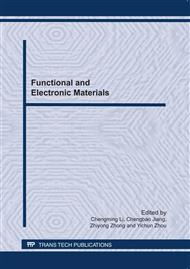[1]
K. Tanaka, H. Tobushi and S. Miyazaki, Mechanical Properties of Shape Memory Alloys, 1st ed., Yokendo, Tokyo (1993) pp.62-122.
Google Scholar
[2]
M. Tokuda, Y. Men, B. Bundara and P. Sittner, Multi-axial Constitutive Equations of Polycrystalline Shape Memory Alloy (1st Report, Modeling and Formulation), Trans. JSME, A, 65-631, 491-497 (1999).
DOI: 10.1299/kikaia.65.491
Google Scholar
[3]
L. C. Brinson, One-Dimensional Constitutive Behavior of Shape Memory Alloys : Thermomechanical Derivation with Non-Constant Material Functions and Redefined Martensite Internal Variable, J Intelligent Material Systems and Structures, 4, 229-242 (1993).
DOI: 10.1177/1045389x9300400213
Google Scholar
[4]
M. Panico and L. C. Brinson, A Three-Dimensional Phenomenological Model for Martensite Reorientation in Shape Memory Alloys, J Mech Phys Solids, 55, 2491-2511 (2007).
DOI: 10.1016/j.jmps.2007.03.010
Google Scholar
[5]
A. Suzuki, H. Shibutani, T. Yamamoto, T. Sakuma and H. Baba, A study on the Accommodation Mechanism of the Transformation in Shape Memory Alloys, Proc. 57th conf. of JSMS, 205-206 (2008).
Google Scholar
[6]
A. Suzuki, W. Araki, H. Shibutani, T. Yamamoto and T. Sakuma, A Constitutive Model for Stress and Temperature Induced Phase Transformation of Shape Memory Alloys under Multi-axial Stress, Proc. Conf. on Strength of Materials (M&M2008), JSME, OS1001 (2008).
DOI: 10.1299/jsmemm.2008._os1001-1_
Google Scholar
[7]
A. Suzuki, A Modified Fraction Model for the Viscoplastic Behavior of Metals" Proc. of the International Conf. on Creep , 86, 471-476 (1986).
Google Scholar
[8]
G. I. Taylor, Plastic Strain in Metals, J. Inst. Metals, 62, 307-324 (1938) pp.307-324.
Google Scholar
[9]
R. R. Adharapurapu, F. Jiang, K. Vecchio and G. T. Gray , Response of NiTi Shape Memory Alloy at High Strain Rate: A Systematic Investigation of Temperature Effects on Tension-Compression Asymmetry, Acta Materialia, 54, 4609-4620 (2006).
DOI: 10.1016/j.actamat.2006.05.047
Google Scholar
[10]
K. Tanaka, H. Tobushi and S. Miyazaki, Properties of Shape Memory Alloys, 1st ed., Yokendo, Tokyo (1993) p.86 and p.94.
Google Scholar
[11]
K. Ootsuka, et al., Shape Memory Alloys, 1st ed., Ed. by H. Funakubo, Sangyo Tosho, Tokyo (1984) pp.22-23.
Google Scholar


